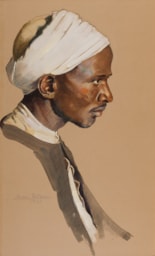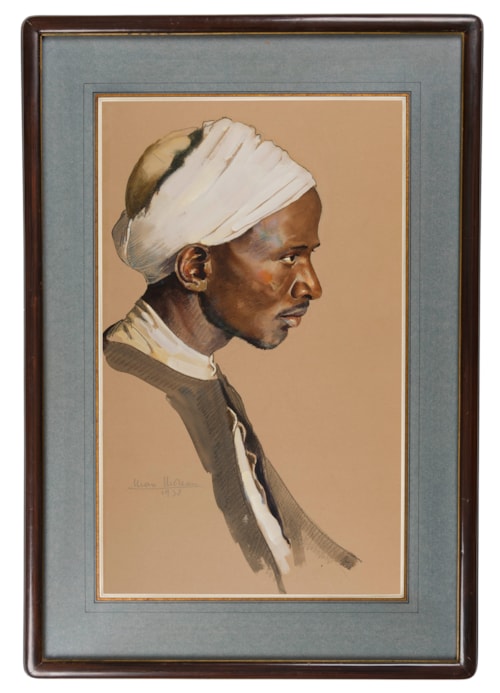Max MOREAU
(Soignies 1902 - Granada 1992)
The Head of a Berber Man in Profile
Sold
Black chalk, watercolour and gouache on buff watermarked paper.
Signed and dated Max Moreau / 1938 at the lower left.
488 x 298 mm. (19 1/4 x 11 3/4 in.) [image]
504 x 323 mm. (19 3/4 x 12 3/4 in.) [sheet]
Signed and dated Max Moreau / 1938 at the lower left.
488 x 298 mm. (19 1/4 x 11 3/4 in.) [image]
504 x 323 mm. (19 3/4 x 12 3/4 in.) [sheet]
Dated 1938, the present sheet was drawn on one of Max Moreau’s visits to Tunisia. While the artist lived and worked mainly in Tunis, he also visited the island of Djerba and the towns and cities of Gabès, Kairouan, Kébili, Nabeul, Sfax and Sousse. As Moreau described the people of Tunisia, ‘What a pleasure it is for the enchanted portraitist who wanders through the labyrinth of the Arab city and the quartiers of the Hara. At every step are heads of character, at every street corner, living models out of the Bible. Misery, suffering, old age, disease have hollowed out this face; youth and beauty irradiate that one; this Bedouin woman passes like a princess in nameless rags of admirable colour; this grave rabbi bears on his features the full weight of a formidable past... Admirable draperies of which the Arabs have the secret, a burnous thrown proudly over the shoulder, turbans rolled up carefully or devilishly…And these hollowed, tormented faces, these eyes which keep the vision of deserts, these wrinkles which speak eloquently...’
As the 20th century art dealer and auctioneer Alphonse Bellier noted of Moreau, on the occasion of an exhibition of his Moroccan work at the Galerie Bernheim-Jeune in Paris in 1951, ‘This painter, born in the mists of Belgium, is in love with the warm lights of North Africa and, like [Albert] Marquet, although in a totally different way, he excels at rendering the violent, sometimes even trembling, beauty of Islam, asleep for centuries in a picturesque world that never disappoints. The classical purity of the Shilha people, the shops of the souks, where his love of chiaroscuro gives joy to his heart, allow him to note, in profound drawings, the history of this Islam that he loves and understands.’
Among stylistically comparable drawings by Max Moreau is a watercolour and gouache study of an Arab man, dated 1937, formerly in the collection of the Broun family at Coulston in Scotland and sold at auction in 2017, as well as a similar study of a Moroccan man playing the flute, drawn in Marrakesh in 1950, which appeared at auction in Paris in 2005 and 2007.
As the 20th century art dealer and auctioneer Alphonse Bellier noted of Moreau, on the occasion of an exhibition of his Moroccan work at the Galerie Bernheim-Jeune in Paris in 1951, ‘This painter, born in the mists of Belgium, is in love with the warm lights of North Africa and, like [Albert] Marquet, although in a totally different way, he excels at rendering the violent, sometimes even trembling, beauty of Islam, asleep for centuries in a picturesque world that never disappoints. The classical purity of the Shilha people, the shops of the souks, where his love of chiaroscuro gives joy to his heart, allow him to note, in profound drawings, the history of this Islam that he loves and understands.’
Among stylistically comparable drawings by Max Moreau is a watercolour and gouache study of an Arab man, dated 1937, formerly in the collection of the Broun family at Coulston in Scotland and sold at auction in 2017, as well as a similar study of a Moroccan man playing the flute, drawn in Marrakesh in 1950, which appeared at auction in Paris in 2005 and 2007.
The son and pupil of the painter Henri Moreau, the Belgian-born artist Max Léon Moreau demonstrated a talent as a draughtsman from an early age, and began painting in oils at fourteen. By sixteen he was making copies of Old Master paintings at the Musée des Beaux-Arts in Brussels, as well as portraits of the actors of the city’s theatres and cabarets. In 1920 the Moreau family settled in Paris. There the young artist continued to find subjects among the theatrical world, particularly at the Comédie-Française, where he befriended the actor and director Denis d’Inès, of whom he painted numerous portraits over the course of a forty-year friendship. By 1923 Moreau was back in Brussels, where he completed his military service.
Long fascinated by the Near East, in 1929 Moreau made the first of five trips to Tunisia. As he noted of the country in his autobiography, ‘it was, for me, a marvel, and I set to work’, painting both portraits and genre scenes. The artist returned to Tunisia and the Maghreb several times over the next decade, and participated in the Salon Tunisien of 1933 and 1934. Some of his Orientalist work was also included in a series of solo exhibitions in Brussels and elsewhere in Belgium.
Moreau spent much of the Second World War in Vichy and the South of France, and after the war established a successful international career as a society portrait painter. He continued to travel extensively, living in Marrakech between 1947 and 1950 before settling in Paris, while also working in the Bahamas, England, Portugal and America, notably in New York and Palm Beach. In 1960 an exhibition of his work was held at the Wildenstein Gallery in New York. In 1965, after fifteen years in Paris, Moreau settled permanently in Granada in Spain. He continued to enjoy considerable success, with solo exhibitions of his work mounted in galleries in Spain and Belgium, as well as in France, Italy, Portugal, North Africa and in several American cities. The onset of Parkinson’s disease in 1982, however, meant that he no longer exhibited his work after this date. Following his death at the age of ninety, and that of his widow two years later, Moreau’s estate was willed to the city of Granada, which turned his home and studio into a museum - the Casa Museo Max Moreau - that houses some five hundred works by the artist. A posthumous retrospective exhibition of Moreau’s work was held in Granada in 1996.
Long fascinated by the Near East, in 1929 Moreau made the first of five trips to Tunisia. As he noted of the country in his autobiography, ‘it was, for me, a marvel, and I set to work’, painting both portraits and genre scenes. The artist returned to Tunisia and the Maghreb several times over the next decade, and participated in the Salon Tunisien of 1933 and 1934. Some of his Orientalist work was also included in a series of solo exhibitions in Brussels and elsewhere in Belgium.
Moreau spent much of the Second World War in Vichy and the South of France, and after the war established a successful international career as a society portrait painter. He continued to travel extensively, living in Marrakech between 1947 and 1950 before settling in Paris, while also working in the Bahamas, England, Portugal and America, notably in New York and Palm Beach. In 1960 an exhibition of his work was held at the Wildenstein Gallery in New York. In 1965, after fifteen years in Paris, Moreau settled permanently in Granada in Spain. He continued to enjoy considerable success, with solo exhibitions of his work mounted in galleries in Spain and Belgium, as well as in France, Italy, Portugal, North Africa and in several American cities. The onset of Parkinson’s disease in 1982, however, meant that he no longer exhibited his work after this date. Following his death at the age of ninety, and that of his widow two years later, Moreau’s estate was willed to the city of Granada, which turned his home and studio into a museum - the Casa Museo Max Moreau - that houses some five hundred works by the artist. A posthumous retrospective exhibition of Moreau’s work was held in Granada in 1996.
Provenance
La Petite Galerie, Brussels, in 1938
Anonymous sale, Brussels, Hôtel des Ventes Horta, 11 May 2015, lot 199.
Anonymous sale, Brussels, Hôtel des Ventes Horta, 11 May 2015, lot 199.
Exhibition
Brussels, La Petite Galerie, Exposition Max Moreau, October 1938, no.35.





